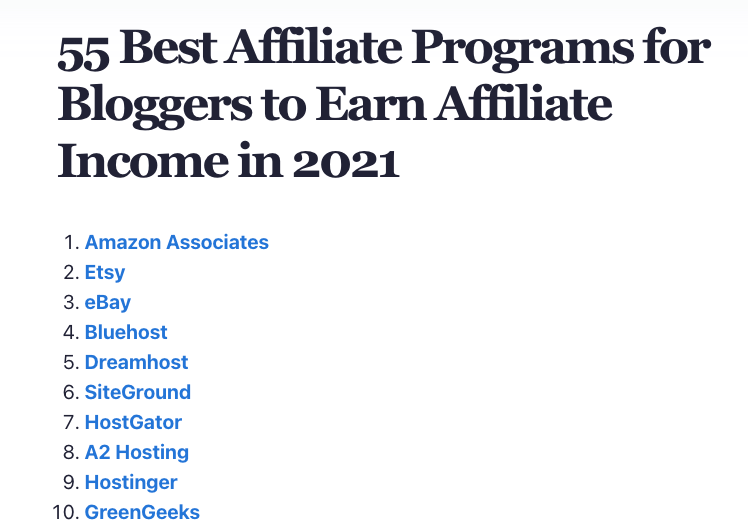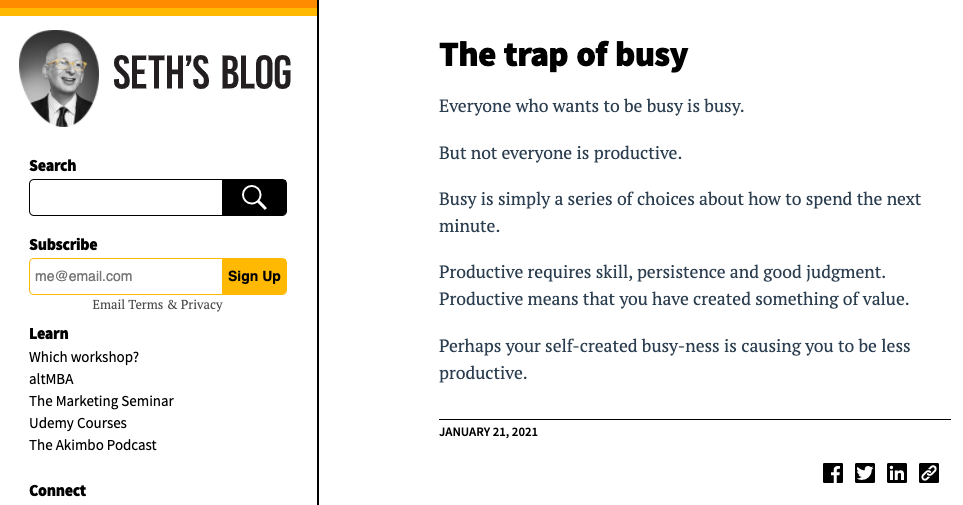Want solid proof that blog post structure matters a lot? Let’s do a little thought experiment… have you made it part of the way through reading a blog post and just felt a bit lost? Perhaps you’ve had the thought… “hurry up and get to the point already!”
Or maybe you’ve wondered whether or not a blogger simply forgot to include half the article by mistake, because it ended so abruptly?
All of these issues indicate a clear problem with the blog post structure at-hand.
The structure of your blog post is like the walls and roof of a house—it’s important to build those features in from the moment you start a blog. Without having your walls and roof firmly and securely in place, you could have fancy wallpaper and nice decorations… but nobody will actually want to live there. It’s the same with a blog post. You could have brilliant ideas and an amazing way with words… but without an effective blog post structure, the whole thing will come crashing down.
How to Create a Blog Post Structure That Engages Readers in 4 Easy Steps
- Why is Having a Blog Post Structure So Important?
- Simple Blog Post Structures That Work Every Time
- Writing Powerful Introductions and Conclusions
- Clever Ways to Make Your Blog Post Structures More Advanced
Disclosure: Please note that some of the links below are affiliate links and at no additional cost to you, I’ll earn a commission. Know that I only recommend products and services I’ve personally used and stand behind. When you use one of my affiliate links, the company compensates me, which helps me run this blog and keep all of my in-depth content free of charge for readers (like you).
Want My Complete Blog Post Template?
Pick up my free blog post template and create more compelling content today.
Now, let’s lay the foundation by talking about why learning how to create a blog post structure—that matches the expectations of your readers—is worthy of your time & attention this year.
1. Why is Having Blog Post Structure So Important?
Getting your blog post structure dialed in properly (for your target audience) has a lot of advantages over the long haul for the future growth of your blog. It means that:
- Your post will offer a much better reading experience: Your readers will stick around till the end, instead of wandering off partway through
- Your post will be truly valuable: It’ll offer well-organized, thorough content that readers will want to share and come back to again and again
- You won’t have to spend so much time figuring out what to write: If you often sit staring at the screen (or out of the window) while writing a post, wondering where the hell to go next, then spending a few minutes learning about structure could make a huge difference
- You won’t need to do much editing: Instead of cutting out whole paragraphs or even sections that simply don’t fit your post, you’ll be writing material that’s going to work in the context of your post as a whole
- You’ll be able to provide more depth and insights for your readers: A good, detailed post structure will push you to make your content as useful and valuable as possible, which serendipitously keeps readers coming back for more—and that reassures them that your paid offers will be just as well-organized
There are plenty of tried and tested blog post structures that you can use for laying out your articles. Once you know what they are, you’ll see them being used on other blogs—over and over again.
Tip: Some bloggers worry that following a specific blog post structure will inhibit their creativity. In fact, once you try structuring your posts well from the start, you’ll find it frees you up to be more creative. You may even find that specific structures help prompt you toward new ideas for your blog.
We’re going to first look at two simple, yet extremely effective blog post structures to draw some inspiration from in your writing process. After that, we’ll dig into some easy, powerful ways to extend these simple structures into a more finessed result. Finally, we’ll talk about how to tastefully borrow inspiration from features you may admire on my blog here… to incorporate into your own blog post structure over time.
2. Simple Blog Post Structures That Work Every Time
In its most basic form, every piece of writing has a beginning, middle and end (or at least, it certainly should). With blog posts, we often call these core structural components the introduction, main body and conclusion.
Normally, the introduction and conclusion will be quite short. For a 1,000 word post, the three parts might break down into something like this:
- Introduction: 100 – 200 words
- Main body: 700 – 850 words
- Conclusion 50 – 100 words
Each of the blog post structures we’ll be covering in this guide make use of these three basic components, because the vast majority of readers are already primed to expect these structural elements as a matter of habit. If you’re interested in crafting alluring headlines, check out my ultimate guide: How to Write a Headline (That Captures Attention).
Easy Blog Post Structure #1: The List Post
Let’s take a look at one of the most popular types of blog post structures in the wild today—the list post (or listicle), which is a format I do very well here on my blog. For example, here’s a screenshot from my list of the Best Affiliate Programs for Bloggers:
Now, here’s how this content structure breaks down from the perspective of utilizing our three core structural elements:
- Introduction: In the introduction to a list post, you explain the problem or topic that you’re discussing. This is also where you want to draw the reader in by hooking their interest. (We’ll come onto some specific tips for introductions shortly.) At the end of the introduction, you’ll want a line introducing the list. For instance, “Here are my favorite X places to visit in Chicago.”
- Main Body: The main body of your list post should have numbered points. These will normally start at #1 (though you could write a “top X” post that begins with the highest number and counts down to #1). Each of your numbered points should ideally be structured in the same way. If you have a lot of points, you might want to write a list so each point is just a sentence or two. If you have a smaller number of points, though, it normally makes sense to have a subheading for each point, followed by a paragraph or two of explanation.
- Conclusion: At the end of the list, you’ll want to include a paragraph or two that sums up. It’s really common to see newer bloggers missing off the conclusion on list posts. If you don’t have a conclusion, and your post simply ends with the final item on the list, that can feel jarring for readers – as if you’ve accidentally forgotten to finish the post. Your conclusion could be as simple as a line saying “Which of these ideas did you like best?” or “Which of these will you try this week?”
Fear not, we’ll get to some more specific insights and actionable steps to writing useful conclusions later on in this guide.
4 Different Types of List Blog Post Structures You Can Follow
One great thing about the list-driven blog post structure, is that it’s endlessly versatile. You could use it for things like:
- A top 10 list of tools or resources on a particular topic related to your niche
- A weekly round-up of your favorite recent blog posts, podcast episodes, or videos
- A list of ideas or tips for a particular topic, which the reader could pick and choose from
- A “how to” post that gives instructions on how to accomplish something specific, which should be ordered chronologically (in the order the reader will need to carry out the steps)
On some blogs, pretty much every post is a list post… and yet they still have plenty of variety.
Easy Blog Post Structure #2: The Essay-Style Post
Another popular (and very effective) content structure to follow, is the essay-style post. This is a post that typically makes one key point or discusses a single topic, sometimes broken down into sections. Here’s an example of a recent essay-style blog post from the prolific author and marketer, Seth Godin:
This straightforward blog post structure can be a very useful tool for a few different types of objectives, including:
- Personal blogging, where you may be writing about a specific event in your life
- Writing a “why” post (like The trap of busy by prolific author and marketer, Seth Godin)
- Writing a “what is” post (like What is a Blog? here in my own blogging resources section)
An essay-style blog post is structured like this:
- Introduction: This is where you introduce your key topic or maybe pose a question to the reader
- Main Body: For an essay-style blog post structure, you’ll want to split the main body of your content into several sections. Usually, you’ll need between 2 and 4 subheadings. These should break your core point into smaller pieces, so that you can cover different aspects of it. Ideally, you want each section to be roughly the same length. It doesn’t matter if they vary a bit, but you’ll want to avoid having 2 really short sections and 2 really long ones. With a list post, you should try to structure each section the same way. This isn’t necessary with an essay-style post, where your sections might each look quite different. For instance, one or two sections might include lists or step by step instructions.
- Conclusion: In the conclusion, you’ll want to reiterate your main point or the key thing you want your reader to remember and give them something to do next
One of the best features of an essay-style blog post structure, in contrast to a list article, is that it naturally allows for a more creative flow of your own ideas as the writer.
That’s not to say your essay-style blog post can’t benefit from a little structure enhancements around the edges though. I’m a major advocate of leveraging formatting tools to your advantage throughout your overall layout to keep your readers engaged and draw their attention to important takeaways in your article.
3. Writing Powerful Introductions and Conclusions
Whichever type of blog post structure you decide to go with, it’ll need a clear introduction and conclusion.
Trust me, I know these can be tough to get right. Even experienced bloggers sometimes spend a long time agonizing over them. Here are some practical tips to help with writing more effective introductions and conclusions (to enhance your blog content):
Writing Introductions that Hook the Reader (and Draw Them in)
The first few sentences of any blog post should strive to accomplish two crucial tasks:
- Grab the reader’s attention
- Set the post up so the reader knows what to expect
Some easy, yet highly effective ways to start your introduction are:
- With a question: For example, How to Start a Food Blog begins with “Want to learn how to start a food blog, but have no clue how to go about it?”
- With an interesting or famous quotation: This can be a good way to kick off your post if you’re not quite sure how to start, or if you’re writing something that’s designed to be inspiring or motivating.
- With an eye-catching statistic or fact: 10 Blog SEO Strategies opens with, “Now that we’re in 2021, a whopping 93% of online experiences start with a search engine, and for 92.04% of those users, Google is their search engine of choice.”
- With an acknowledgment of the main problem your reader is facing: 7 Best Free Web Hosting Plans begins with, “When it comes to finding the best free web hosting plans to get your blog off the ground completely free, there are quite a few confusing (to put it nicely) options out there.”
The rest of your introduction should set the stage for the key points to come in the rest of your post, which is the real magic of thoughtfully curating your blog post structure. You might explain why the topic matters, or you could empathize with the reader’s challenge (that brought them to your post in the first place).
Often, it’s a great idea to use your introduction to tell the reader what they’re going to learn throughout the post at-hand, or paint a clear picture of what they’ll be able to accomplish by the time they’ve read it.
Writing Conclusions That Encourage Your Reader to Take Action
The conclusion to your post doesn’t need to summarize everything you’ve written. In fact, some of the most effective blog post conclusions are short and succinct.
Instead, lean into a blog post structure that utilizes the conclusion as a destination to reiterate the key point(s) you want to impart with your readers. Your conclusion should also ideally suggest a very clear next action step to take—often referred to as a “call-to-action.”
A few great strategies for writing a highly effective blog post conclusion, are to:
- Encourage readers to take action on what they’ve just read: This is particularly useful if this action will help you in some way. How to Start a Food Blog ends with “Start your food blog today and with a healthy dose of hard work, creativity and the willingness to experiment, you’ll see results quickly.”
- Invite readers to leave a comment: You could simply write something like, “Which of these tips will you try first? Let us know in the comments.” Or “Do you have any tips to add to our list? Share them in the comments.”
- Suggest another post on your blog that readers might enjoy: How to Start a Travel Blog ends with “Want more tips on growing your blog readership fast? Be sure to check out my guide: 10 Blog Marketing Strategies (to Grow Quickly)…” which serves up a useful, relevant second article for interested readers to check out next.
- Encourage readers to buy one of your products or check out your services. This works particularly well if your post ties in with the same topic. For instance, if your post is a list of tips for self-editing your own writing, you might end it with, “Need an extra pair of eyes on your writing? Check out my editing and proofreading services.”
4. Clever Ways to Make Your Blog Post Structures More Advanced
Before you go too far with any particular blog post structure, I’d encourage you to make sure you’re nailing all the basics. That includes these best practices:
- Checking that your article has a strong introduction that doesn’t run too long: It’s important to hook the reader, but you don’t want to end up going off on a tangent before you’ve truly gotten into the main body of your post.
- Making sure you have a conclusion for your post: This might just be a sentence or two, but it’s important to any smart blog post structure that you have something there. Your conclusion lets you round off the post and give the reader something to remember. This is also a great opportunity to prompt the reader to take action—you could encourage them to join your email list, download a free resource, share your post on social media, check out one of your paid products, schedule a no-obligation introductory call with you, or whatever you most want them to do.
- Including subheadings in your blog post structure: For a list-style structure, these should be numbered, but for an essay post, they generally shouldn’t. Subheadings are like signposts to the reader, telling them what’s coming up. They’re really helpful for readers who are skimming to find an answer to a specific question, as well as for readers who might otherwise feel lost in lots of dense paragraphs of text.
Once you’re confident that you have a great handle on the basics, go ahead and make your content structures more complex. Both the list post and essay-style post structures are wonderfully versatile, and there’s a lot you can do to extend the usefulness your posts with these structures.
Here are some great places to start adding a little more nuance to your blog post structure—and benefit readers immensely along the way:
Add Extra Value and Consistency to Your Post Structure by Including Subsections
One very easy way to add extra value to the structure of your blog posts, is to include one (or more) subsections within each of your main sections or list items throughout the article.
Here’s an example, from 15 Best Web Hosting Plans for Bloggers, with the subsections indicated using red arrows:
With many posts, you can easily add a “quick tip” at the end of each section to inject a little additional value into your blog post structure. Another simple option is to highlight some “Further Reading” or offer up a clickable link to “Go Further,” which gives you a ready-made opportunity to include links to other posts on your blog, to paid products, or to affiliate offers.
With a list post that shares your favorite software or tools, useful extra sections include “Pricing,” “Pros,” “Cons,” or “Alternatives” to help direct readers toward important information.
If you want some more inspiration, check out these examples of articles (here on my blog) that use clever headings throughout their blog post structure to keep readers attention on the most important takeaways to focus on in each article:
- 21 Best Podcast Hosting Platforms to Use (Free and Cheap)
- 8 Best Monthly Web Hosting Plans (Month-to-Month Payment) for Bloggers
- 10 Best Free Blogging Sites to Build Your Blog for Free: Tested, Compared, Reviewed
- How Much Does Web Hosting Cost? 7 Hosting Costs Compared
- 25 Bluehost Reviews: An Honest Compilation (Including Performance Statistics)
Remember that these kinds of sections make it easy for readers to take in the information you’re sharing, and figure out which tips or tools might work best for them. As an added bonus, these blog post structure features also help make your content look more visually interesting and appealing.
Add Visual Intrigue to Your Posts by Including an Image in Each Subsection
Another great way to make your blog post structures more engaging, is to add images throughout your content. You’re probably already including an image at the top of your post, to draw the reader in. But long posts, in particular, benefit from having more images to break things up.
One simple way to do this is to add an image at the start of each subsection or list item within your post. Here’s an example, from 27 Best Blogging Courses for All Bloggers to Grow:
You don’t necessarily have to add images at the beginning of every subsection though, feel free to get creative with it. You may choose to have an introductory paragraph first, then the image, then dive into the rest of the subsection.
Cover a Topic In-Depth By Breaking a List Post into Separate Parts
Sometimes, you might have a topic that doesn’t work as one single list. You can create a more complex post structure using subheadings to divide your post into two or more separate parts.
At its most basic, this technique could mean having a “Why” section before you jump into the list, like 29 Best WordPress Themes for Bloggers does with the section “Why WordPress Themes?”
If you have a list that can naturally be split into groups, you can go further with this technique and divide the list itself into different parts.
Here’s an example, from my recently updated compilation of 40 Blogging Tips to Grow Your Audience, which is split into four main sections:
Each part of the post has a subheading, an introduction, and then a set of tips, like this:
Splitting a long list up like this helps the reader to take in the ideas, as tips that relate to the same area of blogging are all grouped together. It’s still a continuous list, as the numbering carries on each time (i.e. the section pictured in the screenshot above, starts with item #28 on the list).
Another way you might split up a list post is by creating two separate lists, and restarting the numbering. You can see this technique in action in How to Name a Blog (the Smart Way), where there’s a list of 10 quick and easy tips, followed by a separate list of six detailed techniques, then a final list of 40 examples
Help Readers Find What They Need (with a Table of Contents)
If you have a long post, another great way to add to the structure is to create a WordPress table of contents before launching into your list items. This helps readers to jump straight to the parts that interest them most, or to get back to where they left off in a long how-to post.
Here’s an example, from my ultimate guide about How to Start a Blog (and Make Money):
The absolute best argument to begin incorporating a table of contents into your default blog post structure, is that readers will be able to click on any of those links (subsections) to jump straight down to the right part of the post that they’re most interested in reading about.
You can use a simple WordPress plugin (like AutoListicle) to create a table of contents that organizes the main points of your blog post—or you can even create it yourself with anchor links if you’re comfortable using a little light HTML code on your blog. Check out this tutorial of mine to see how to make one for yourself in just a few minutes.
Wrapping Up: Use a More Thoughtful Blog Post Structure Today
If you’re still wrapping your head around everything that comes along with choosing to thoughtfully curate your blog post structure moving forward, then let’s take a step back…
Let’s begin with just the basics of enhancing the structure of one article:
- First, choose an existing post on your blog: Make sure it has an introduction, a few useful subheadings and an actionable conclusion
- Next, pick one way to add extra structure to that post: Maybe you’ll include a “top tip” for each section, add an image directly beneath each subheading or inject a table of contents for readers to more easily navigate the key takeaways throughout your article
With the next new article you write for your blog, spend a little bit of time thinking about which features here could contribute to the most effective blog post structure for communicating your ideas & takeaways before you begin.
In my experience by doing this work upfront, you’ll find that the writing comes more easily (and quickly), your content will come together more cohesively and it’ll make more of an impact with your readers too.
For more tips on writing great content that helps transform your readers, check out my ultimate writing guide: How to Write a Blog Post (+ My Free Blog Post Template).
This guide is packed with actionable tips for enhancing your blog posts and making them as effective as possible for your readers.
Want My Complete Blog Post Template?
Pick up my free blog post template and create more compelling content today.












How can I join or register?
Do you mean, how can you download my blog post template? If so, you can head over here (and submit the form with your name/email) to pick it up right away: https://www.ryrob.com/blog-post-template/
Great stuff sir!
Really it helps a lot to a new blogger like me.
I found most of your articles are super lengthy. And I know it is a strategic key to your success. But here, I have a question.
“A page of 1500 words has nearly 30 backlinks and on another side, a 4000-word article has only 5 or no backlinks.”
Which post ranks high on Google? In simple words Backlinks VS page content.
Thanks for the kind words! Unfortunately, I don’t believe there’s a super simple answer to your question… there are definitely a LOT more factors involved (how competitive the search terms are, what the search intent is for an average reader, on-page SEO factors with both your article and the overall site, how much monthly search volume there is, etc). So, there’s no worthwhile answer as simple / straightforward as you’re hoping for.
That being said, here’s my quick take:
For a keyword phrase with low-medium competition: I’d take my chances with super long-form content and a small number of quality backlinks.
For a keyword phrase with medium or high competition: Give me the shorter-form piece, but make sure it earns a substantial number of quality links (relatively quickly).
I have got very nice ideas about the structure of blog post and how to make it user-friendly, thanks
You’re so welcome, Dipak! Good luck with your blog 🙂
Hi Ryan,
I am an avid reader of your blog post for last 6 months. These write-up always stimulate me to upgrading and learning new things.
Waiting for the next…
Ah, thank you for the kind words, Ruhi! 🙏
This is such an informative article! Thank you for providing such valuable content for free. I’m definitely going to be reccomending your site to fellow bloggers and site creators!
Ah, thanks so much for the kind words Courtney. Good luck with your blog as well 🙂
Great article! Excellently signified the importance of blog structure!